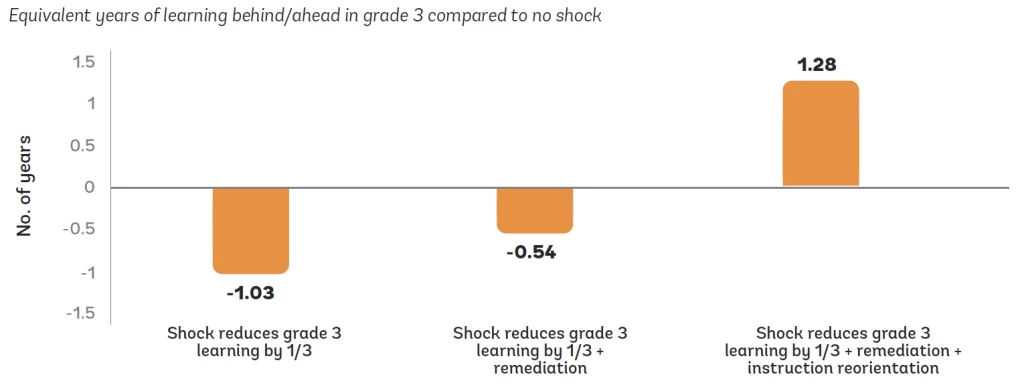 Addressing curriculum and instruction challenges can help to ensure that students gain a sufficient foundation for their learning. Copyright: Dominic Chavez/World Bank
Addressing curriculum and instruction challenges can help to ensure that students gain a sufficient foundation for their learning. Copyright: Dominic Chavez/World Bank
Before the COVID-19 pandemic, global learning levels were unacceptably low, slow to improve, and uneven. In 2019, the average learning poverty rate — the proportion of 10-year-old children unable to read and understand a simple text — was 57 percent across low- and middle-income countries. The global setback of the pandemic increased this rate to an estimated 70 percent, with the most vulnerable students taking the greatest hit.
A new World Bank report, Learning Recovery to Acceleration, investigated 60 countries’ efforts to improve learning and reduce inequalities after schools reopened through the lens of the RAPID Framework. Among the five key policy areas of the framework, two directly address curriculum and instruction: prioritize teaching the fundamentals and increase the efficiency of instruction, including through catch-up learning.
The report finds long-standing classroom challenges related to curriculum and instruction, with the pandemic adding pressures due to lost instructional time and the need for catch-up learning. These challenges can be summarized as two “over”s and one “under”: over-loaded curricula, over-ambitious pace, and under-focused instructional approaches. Addressing these challenges will help to ensure that every child and youth gains a sufficient foundation for their further learning.
Over-loaded curricula
In many countries, curricula are overburdened and imbalanced. New content is added over time without making space. This leaves too little time for the development of foundational skills such as literacy, numeracy, and socioemotional skills. On top of this, lost instructional time due to the pandemic placed pressure on schools to cover the curriculum in less time. As a result, children and youth do not master the foundational learning essential for further education success.
The report found that 37 percent of the 60 investigated countries had instituted more focused curricula, prioritizing foundational skills for at least one academic year after schools reopened. For example, Guyanareleased a more focused national grades 1–9 curriculum in 2021 that prioritizes mathematics, language, science, and social studies. Duplicated content areas were omitted, and other topics were integrated based on logical connections. The government currently plans to implement this focused curriculum for four years, but will adjust based on how well the program is working and how quickly students are catching up.
Over-ambitious pace
When the expected pace of learning in the curriculum is misaligned with the actual pace of learning, teachers are unable to provide the instruction that enables students to master essential knowledge and skills. This can happen when the curriculum moves either too fast or too slow, but it is often the case that over-loaded curricula move at an over-ambitious pace. Students may fall multiple grade levels below expectations as a result.
Learning could accelerate if curricula were built around the learning pace of students. A simulation model (figure 1) illustrates the benefit of aligning the pace of curricula with the pace of student learning. The model shows that a three-month school closure with no remedial intervention results in more than one full year’s worth of learning losses. While remediation alone can reduce long-term learning loss by half, remediation combined with long-term reorientation of instruction to align with children’s learning levels increases learning by more than one full year.
Figure 1. Modeling long-term learning loss from school closures and mitigation strategies

Note: This figure uses a calibrated “pedagogical production function” model to estimate the potential long-term losses to children’ learning from a temporary shock of school closures and the gains possible from 2 mitigation strategies.
Some countries have sought to better align their over-ambitious curricular pacing with the pace of student learning by reducing curricular content. Others have done so by adjusting instructional time or adjusting teaching approaches and temporary student groupings.
In Armenia, schools have been given flexibility and funding to respond to their students’ needs by deciding how much instructional time to dedicate to individual subjects. When students' proficiency levels vary too much within classes, periods of targeted instruction in which students are grouped and regrouped according to achievement levels for part of the school day or year has been found to be a cost-effective way to increase learning of all children across different contexts. Brazil, Ghana, India, and Zambia are implementing this approach to help ensure that all children develop foundational skills.
Under-focused instructional approaches
Teaching is a complex and challenging job. The pandemic further complicated that job, while highlighting the critical role of effective teaching. To prioritize the fundamentals and increase the efficiency of instruction, lesson planning and implementation need to focus on what students should learn and how they will learn it. Without this focus, education systems struggle to equip children with basic skills even when those children spend years in school.
Many systems have provided scaffolds to help teachers move toward more effective practices by providing aligned support, guidance, and resources. Structured pedagogy packages have been found to be a cost-effective way to help teachers accelerate student learning through maximizing instructional time and effectiveness. These packages align student materials, teacher guides with lesson plans, teacher training, and ongoing support to enable more focused instruction with systematic progression.
Structured pedagogy programs have been scaffolding the teaching of foundational literacy and numeracy at scale in Benin, Jordan, and Timor-Leste, among others. In Benin, the program’s new teacher guides and student learning materials are built around the kind of focused, phonics-based instructional approach that has proven effective: teachers are guided to introduce letter symbols and sounds one by one in each lesson and provide sufficient time for practicing decoding skills, a necessary precursor for reading fluency.
Better pedagogical and curricular approaches like these can make a substantial difference for learning. Without them, pre-pandemic problems will continue to impede post-pandemic recovery. Over-loaded curricula, over-ambitious pace, and under-focused instructional approaches are hampering efforts to recover and accelerate learning following the disruptions of the pandemic. But the encouraging evidence presented in the new report is equally clear: when countries prioritize the teaching of the fundamentals and make efforts to increase the efficiency of instruction, every child can thrive in the classroom.
To receive weekly articles, sign-up here




Join the Conversation